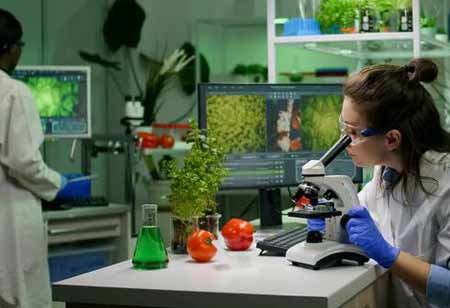Thank you for Subscribing to Agri Business Review Weekly Brief
The Advanced Science of Agricultural Specialty Nutrients
The agricultural specialty nutrients sector plays a vital role in enhancing crop productivity, promoting sustainable practices, and providing tailored nutrient solutions, driven by growing food demand and increasing environmental awareness.

By
Agri Business Review | Monday, July 28, 2025
Stay ahead of the industry with exclusive feature stories on the top companies, expert insights and the latest news delivered straight to your inbox. Subscribe today.
The agricultural specialty nutrients manufacturing sector is a crucial pillar in the global effort to enhance crop productivity, optimize resource utilization, and promote sustainable farming practices. This industry focuses on developing and producing fertilizers that go beyond the traditional primary macronutrients (nitrogen, phosphorus, and potassium) to offer targeted solutions for specific crop needs, soil conditions, and environmental considerations. The overarching trend within this sector is a robust expansion, driven by the increasing demand for high-quality food, the imperative of maximizing crop yields on finite arable land, and a growing global awareness of soil health and environmental stewardship.
Manufacturing Processes: Precision and Innovation
The manufacturing of agricultural specialty nutrients is a complex and highly controlled process that emphasizes precision, efficiency, and consistency. In contrast to the large-scale production of commodity fertilizers, the development of specialty nutrients incorporates advanced techniques such as chemical synthesis, granulation, and coating technologies to enhance product performance and application efficiency.
Granulation plays a pivotal role in producing specialty fertilizers in granular form, which facilitates ease of handling, uniform field application, and controlled nutrient release. This process involves the agglomeration of fine particles into larger granules, which are often coated with polymers or resins to regulate the rate of nutrient dissolution. The choice of coating materials and the application method are critical factors in achieving the intended nutrient release profile.
Chemical synthesis is employed to produce water-soluble and chelated micronutrients, involving precise reactions that yield highly pure and bioavailable forms of these nutrients. Continuous investment in research and development enables manufacturers to innovate formulations that enhance nutrient stability and plant uptake.
In the production of customized nutrient blends, accurate blending and homogenization are essential to ensure the even distribution of all components. This consistency is particularly vital for multi-nutrient products, where uniform delivery of each nutrient is necessary for optimal plant health and performance.
Throughout the entire manufacturing process, stringent quality control measures are maintained—from raw material assessment to final product evaluation—to ensure that the specialty nutrients meet rigorous standards for nutrient content, purity, particle size, and controlled-release behavior.
Application Methodologies: Tailored Delivery for Optimal Impact
The effectiveness of agricultural specialty nutrients is closely tied to the precision and method of their application, which often surpasses that of conventional fertilizers in both accuracy and efficiency. One of the most efficient techniques is fertigation, which involves dissolving water-soluble specialty nutrients in irrigation water and delivering them directly to the plant's root zone. This method enhances nutrient and water use efficiency, reduces losses, and enables precise nutrient delivery in alignment with crop growth stages and demand.
Foliar application is another targeted approach, wherein nutrient solutions are sprayed directly onto plant leaves, facilitating rapid absorption. This method is particularly advantageous for addressing acute deficiencies, especially of micronutrients, as it circumvents soil-related constraints that may hinder root uptake.
Likewise, seed treatment and in-furrow applications provide young seedlings with immediate access to essential nutrients at planting, fostering robust root development and early vegetative growth. Precision placement methods, such as banding or deep placement, further improve nutrient efficiency by applying fertilizers in localized zones near the root area, thereby minimizing nutrient immobilization and losses to the broader soil matrix.
Growth Drivers: Fueling the Industry's Trajectory
The global agricultural specialty nutrients industry is experiencing robust growth, driven by several interrelated and powerful factors. Foremost among these is the increasing global demand for food, driven by a continually expanding population. This escalating pressure necessitates increased agricultural productivity from existing or even declining arable land, making specialty nutrients essential for enhancing crop yields and quality. Simultaneously, there is a growing emphasis on sustainable agricultural practices that prioritize environmental stewardship and resource efficiency. Specialty nutrients play a significant role in this context by enhancing nutrient use efficiency, reducing runoff, and mitigating environmental impacts, thereby supporting long-term sustainability goals.
Advancements in precision agriculture—encompassing technologies such as remote sensing, data analytics, and GPS-guided systems—have heightened the demand for nutrient solutions that can be accurately applied based on real-time field data. This enables highly targeted nutrient management strategies that optimize inputs and maximize returns. In addition, increased awareness of soil health and regional nutrient deficiencies among farmers and stakeholders is further propelling the need for customized nutrient products. Lastly, the rising cultivation of high-value crops, including fruits, vegetables, and ornamentals, which require precise and specialized nutrient management, is amplifying the demand for specialty nutrients tailored to their unique growth and quality requirements.
The future of agricultural specialty nutrients manufacturing appears robust and is characterized by a continued drive for innovation and sophistication. Research and development efforts are concentrated on developing even more efficient and environmentally benign products. This includes advancements in nanotechnology for ultra-efficient nutrient delivery, the expansion of biostimulant and biofertilizer portfolios, and the integration of artificial intelligence and machine learning to create "smart" fertilizers that respond dynamically to plant needs.
The industry is poised for further growth as agricultural practices evolve to meet the dual challenges of food security and environmental responsibility. Manufacturers will continue to focus on developing products that not only enhance crop productivity but also contribute to healthier soils, cleaner water, and a more sustainable agricultural ecosystem for future generations. The emphasis will remain on delivering the "right nutrient source, at the right rate, at the right time, and in the right place," ensuring that every unit of nutrient applied translates into maximized agricultural output and minimized environmental footprint.





